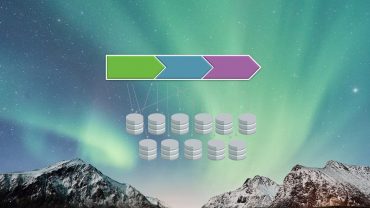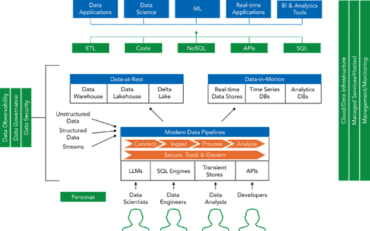
Transformation requires being able to use the tons of data being generated today from devices and applications. But what’s the real path to innovation?
Today, enterprises are moving toward digital transformation as a matter of survival. Companies that can innovate and partner across ecosystems to disrupt industries and create greater, more immediate customer value using technology are the winners in the data-driven economy. Digital transformation, defined as the use of technology to rethink product and service delivery rather than to improve traditional processes, requires being able to securely apply and share the copious amounts of data being generated today from devices and applications.
This data is what drives the new products, services and buying experiences that customers are demanding. In fact, the ability to integrate and manage data effectively is a precursor to digital transformation.
Unfortunately, many businesses aren’t making sufficient progress on their transformation journey, and some leaders feel less confident now than they did a few years ago about their prospects. According to a PwC survey conducted last year, 52 percent of business leaders feel prepared to capitalize on next-generation technologies today, down from 67 percent who were confident in their ability to benefit from technology advances in 2015. What’s behind the loss of confidence?
See also: 4 truths and a lie about digital transformation
One factor may be that aging on-premises integration infrastructures are still setting the pace of change at many companies. The introduction of cloud applications that more easily handle critical processes and generate valuable data is providing the impetus for digital transformation. The move to the cloud has changed the way companies do business and is producing insights and enabling greater innovation as well as efficiency.
But it is also demonstrating conclusively that legacy integration technologies such as ESB/EDI, MFT and middleware solutions aren’t up to the task of integrating data that arrives in a variety of formats from many new cloud-based sources. These solutions are too rigid. Companies must begin to achieve integration infrastructures that are also cloud-based or hybrid in nature and that provide the flexibility to facilitate all patterns of integration.
To solve this dilemma, many IT organizations are turning to Integration Platform as a Service (iPaaS) solutions to integrate data from disparate systems and cloud-based applications. One of several problems with these platforms is that they are built on the same aging legacy technologies that companies now have in place. At best, they are a short-term fix.
IPaaS platforms, as currently defined by industry analysts, are also designed to provide tools to facilitate “do-ii-yourself” (DIY) integrations by developers. While this approach promises greater efficiency in completing integrations, it doesn’t take into account the fact that new data sources are coming online all the time and that creating integration workarounds consumes a great deal of time and attention from scarce IT resources that could be directed more strategically to achieve digital transformation.
Seeing the innovation “resource” found in data
As businesses recognize the power that resides in their data and look for ways to embrace the possibilities in newer data sources like the Internet of Things, they end up devoting even more valuable resources and time to integration projects on iPaaS platforms. Companies that hope to use data to innovate and disrupt their industries find that their data scientists with hard-to-find skills are spending too much of their time serving as “data janitors.” They are also finding that their integration projects are taking far longer than expected, slowing the progress of getting new digital business models and processes to market.
Another issue introduced with iPaaS platforms is maintaining security and privacy of data. Data security and privacy regulations are changing all the time, and many companies find it difficult to keep up. Integration solutions that are advertised as compliant out of the box aren’t a cure-all; the first line of code added by an in-house developer can compromise compliance. Data security and compliance rules involve not just the technology but also the people and processes.
Business leaders realize IPaaS isn’t the ideal approach. But many are also balancing the need to integrate and manage data effectively against the challenges it would cause for the business if they were to “rip and replace” their aging, on-premises B2B/EDI, MFT or middleware solutions. Not only would the “rip and replace” approach precipitously eliminate legacy technologies, it would require an immediate replacement of all associated processes. Such an undertaking would cause major disruptions across the entire chain of operations.
So, rather than fully unlocking the power of their data, companies choose to muddle through with half-measures, creating new workarounds to integrate data as it comes online, struggling with data security and privacy compliance issues, underutilizing the talents of their IT and data professionals and failing to achieve digital transformation. Business leaders who find themselves in this quandary are likely among those who don’t express confidence in their company’s ability to capitalize on next-generation technologies.
Luckily, there’s a better alternative. Companies can partner with an integration and data management expert to handle these tasks on their behalf. This approach fits a broader pattern of seeking outside expertise for functions that fall outside a company’s core competency. The right data integration and management partner will provide enterprises with access to high-quality data on a cloud-based, vendor-agnostic platform that doesn’t tie them to a specific application ecosystem.
With this approach, companies can access a platform that handles all patterns of integration today with the flexibility to manage tomorrow’s data challenges. Ideally, companies can choose a platform developed from the ground up to meet today’s needs, facilitating comprehensive compliance with all data regulation maintained by the vendor and reducing the compliance burden on the company, and flexible enough to be future-proof.
It’s also a good idea to find a platform that offers advanced architecture, such as managed services, to scale with increasing integration needs for digital transformation. A managed services approach enables the vendor to handle all integration and data management, freeing in-house IT staff from integration and data janitor tasks. Enterprises that choose this path can offload data management and compliance tasks, which are growing in complexity.
With this approach, business leaders who are seeking digital transformation can move their operation to the cloud without abruptly halting the use of legacy technologies and requiring their people to reinvent processes on the fly. If they partner with a data integration and management expert that has a managed services offering, enterprises can even offload the move to the cloud to the vendor, benefiting from the migration without unduly disrupting business operations.
In a data-driven economy where digital transformation drives success, information is currency. Companies have access to ever-increasingly volumes of data, but integrating and harmonizing it so that data can be used to improve efficiency and generate insights takes an advanced platform and specific skillset. For enterprise leaders who find themselves at a crossroad — data-rich but infrastructure-poor — a partnership with a data integration and management expert can be the best and fastest path to digital transformation.





























